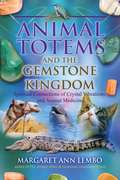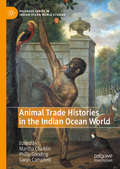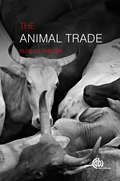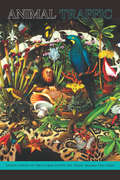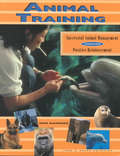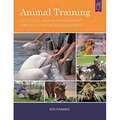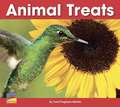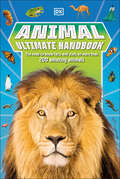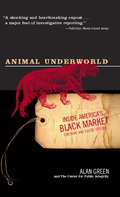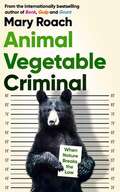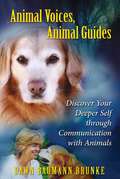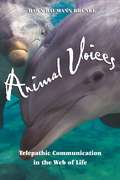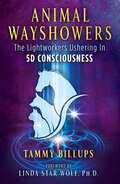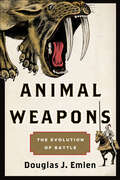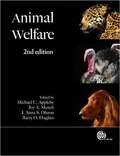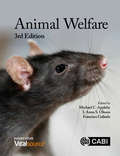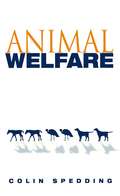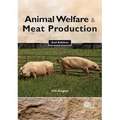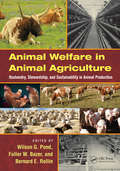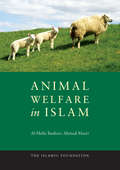- Table View
- List View
Animal Totems and the Gemstone Kingdom: Spiritual Connections of Crystal Vibrations and Animal Medicine
by Margaret Ann LemboShares the wisdom of animals and their matching gemstones to help work on yourself mentally, emotionally, physically, and spiritually • Reveals the energetic connections between 88 different animal allies and 88 gems, stones, and crystals from the mineral kingdom • Includes animal medicine teachings from a variety of creatures, from hummingbirds and cats to dolphins and bears, to help you find inner peace, knowledge, and wisdom • Explains how the color, formation, and the manner in which a stone grows in the Earth offers a teaching to know yourself and your life purpose All creatures, great and small, in all species on this planet are interconnected. When an animal, insect, bird, or other creature from nature appears repetitively, whether in real life or dreams, it is time to pay attention and find the message that nature is bringing you. There are many teachings available to us through the observation of a particular animal totem and their habits and patterns. For example, parrot medicine can teach us to see life from another perspective as we mimic the wise ones who have walked on the path before us. Mouse medicine teaches us to scrutinize all the details before taking action. Bear may teach you to go within yourself to find answers within your personal cave. Every animal is an ally, and every animal has a story to help you find inner peace, knowledge, and wisdom. The associated gemstone for each animal totem is a further indication of the energy of the animal as symbolism and a teaching on your sacred journey. Crystals, minerals, and stones hold the history of the Earth and all this planet has to offer you to evolve your soul and spirit in this incarnation. The color, formation, and the manner in which the stone grows in the Earth offers a teaching to know yourself and your life purpose. It takes time and inner reflection to understand the messages and clues throughout the gemstone kingdom. Matching the teachings of animals with the teachings of gemstones, Margaret Ann Lembo shows how there is symbolism in all around offering clues to light your path. Exploring 88 gems, stones, and crystals and 88 different animal allies, she details the spiritual connections of crystal vibrations and animal medicine, providing you with a deeper understanding of the interconnected energies of everything around us. She shows how the spiritual fulfillment you seek is available to you in so many ways and this path of working with gemstones and animal medicine is just one of many.
Animal Trade Histories in the Indian Ocean World (Palgrave Series in Indian Ocean World Studies)
by Martha Chaiklin Gwyn Campbell Philip GoodingThis book examines trades in animals and animal products in the history of the Indian Ocean World (IOW). An international array of established and emerging scholars investigate how the roles of equines, ungulates, sub-ungulates, mollusks, and avians expand our understandings of commerce, human societies, and world systems. Focusing primarily on the period 1500-1900, they explore how animals and their products shaped the relationships between populations in the IOW and Europeans arriving by maritime routes. By elucidating this fundamental yet under-explored aspect of encounters and exchanges in the IOW, these interdisciplinary essays further our understanding of the region, the environment, and the material, political and economic history of the world.
Animal Trade, The: Evolution, Ethics and Implications
by Clive PhillipsTrade is an inevitable part of human activity and evolution, but when it involves animals there are important ethical issues that have to be considered. Animal trade is often for economic reasons only, and may be hard to justify ethically. There are significant welfare and environmental costs to animals and human society that must be carefully evaluated before such a trade is sanctioned. Controversial and thought-provoking, this text focuses on the trade in live and dead animals and animal parts. It examines the facts and figures to quantify the scope of the animal trade, concentrating mainly on farm animals, but also covering captive wildlife and companion animals. The book describes welfare, environmental, economic and cultural issues around this trade, debating important ethical considerations for everyone that uses or is otherwise involved with animals, especially people in animal welfare.
Animal Traffic: Lively Capital in the Global Exotic Pet Trade
by Rosemary-Claire CollardParrots and snakes, wild cats and monkeys---exotic pets can now be found everywhere from skyscraper apartments and fenced suburban backyards to roadside petting zoos. In Animal Traffic Rosemary-Claire Collard investigates the multibillion-dollar global exotic pet trade and the largely hidden processes through which exotic pets are produced and traded as lively capital. Tracking the capture of animals in biosphere reserves in Mexico, Guatemala, and Belize; their exchange at exotic animal auctions in the United States; and the attempted rehabilitation of former exotic pets at a wildlife center in Guatemala, Collard shows how exotic pets are fetishized both as commodities and as objects. Their capture and sale sever their ties to complex socio-ecological networks in ways that make them appear as if they do not have lives of their own. Collard demonstrates that the enclosure of animals in the exotic pet trade is part of a bioeconomic trend in which life is increasingly commodified and objectified under capitalism. Ultimately, she calls for a “wild life” politics in which animals are no longer enclosed, retain their autonomy, and can live for the sake of themselves.
Animal Training: Successful Animal Management Through Positive Reinforcement
by Ken RamirezA trainer and consultant for nearly 40 years, Ken Ramirez is well regarded as a leader in the animal training world. In his bestselling book Animal Training: Successful Animal Management Through Positive Reinforcement, Ken has selected and organized almost 600 pages of what in his opinion are the best papers, articles, and presentations on the topic of reinforcement-based training, each making a special point, each worth some serious attention. <P><P> Here’s a chance to really explore the thinking and the training protocols involved in reinforcement-based training—whether it’s your dog or a cranky elephant or a group of killer whales. Contributors include the Baileys, many ClickerExpo faculty members, scientists and graduate students, dog trainers, dolphin trainers, zoo behaviorists, and Ken Ramirez himself. Karen Pryor’s work and references to Don’t Shoot the Dog appear throughout. <P><P> This is a year or more of entertaining bedside reading for any training buff, and an important resource for the serious student of operant conditioning. Many of the reprinted articles include data, graphs, training logs, and other background material, and detailed references.
Animal Training: Successful Animal Management Through Positive Reinforcement
by Ken RamirezA trainer and consultant for nearly 40 years, Ken Ramirez is well regarded as a leader in the animal training world. In his bestselling book Animal Successful Animal Management Through Positive Reinforcement, Ken has selected and organized almost 600 pages of what in his opinion are the best papers, articles, and presentations on the topic of reinforcement-based training, each making a special point, each worth some serious attention. Here’s a chance to really explore the thinking and the training protocols involved in reinforcement-based training—whether it’s your dog or a cranky elephant or a group of killer whales. Contributors include the Baileys, many ClickerExpo faculty members, scientists and graduate students, dog trainers, dolphin trainers, zoo behaviorists, and Ken Ramirez himself. Karen Pryor’s work and references to Don’t Shoot the Dog appear throughout. This is a year or more of entertaining bedside reading for any training buff, and an important resource for the serious student of operant conditioning. Many of the reprinted articles include data, graphs, training logs, and other background material, and detailed references. A trainer and consultant for nearly 40 years, Ken Ramirez is well regarded as a leader in the animal training world. In his bestselling book Animal Successful Animal Management Through Positive Reinforcement, Ken has selected and organized almost 600 pages of what in his opinion are the best papers, articles, and presentations on the topic of reinforcement-based training, each making a special point, each worth some serious attention. Here’s a chance to really explore the thinking and the training protocols involved in reinforcement-based training—whether it’s your dog or a cranky elephant or a group of killer whales. Contributors include the Baileys, many ClickerExpo faculty members, scientists and graduate students, dog trainers, dolphin trainers, zoo behaviorists, and Ken Ramirez himself. Karen Pryor’s work and references to Don’t Shoot the Dog appear throughout. This is a year or more of entertaining bedside reading for any training buff, and an important resource for the serious student of operant conditioning. Many of the reprinted articles include data, graphs, training logs, and other background material, and detailed references.
Animal Treats
by Carol Pugliano-Martin Barbara LevadiThis book is about making inferences about the types of food different animals eat.
Animal Ultimate Handbook: The Need-to-Know Facts and Stats on More Than 200 Animals (DK's Ultimate Handbook)
by DKTake a tour of the animal kingdom and learn everything there is to know about the wildlife that inhabits the Earth in this complete guide to animals.Introducing Animal Ultimate Handbook, the latest title in DK&’s Ultimate Handbook series which takes you on a journey of a lifetime as you discover some of the world&’s most incredible mammals, fish, reptiles, amphibians, and insects. Whether you are trekking through the hot and humid rainforest, exploring the dark depths of the ocean, or climbing the snow-capped, icy mountains, you will learn all about some of the extraordinary animals that live on Earth.This ultimate kids&’ factbook includes must-know facts and stats about more than 200 species of animal, from where they live to how they communicate with one another, and much, much more. With modern, detailed illustrations and unique information confirmed by our own animal expert, this book is perfect for inquisitive, young animal lovers.Explore the animal kingdom like you&’ve never done before and discover:-Features captivating, detailed illustrations of the animal kingdom-Full of unique and interesting facts and stats on more than 200 different animals-Special features about animals diets, habitats, communication, and more-Full of detailed illustrations, engaging information and essential facts and statistics about more than 200 animal speciesWith this highly engaging animal book, you will learn to tell your dolphins from your porpoises, predators from your prey, and carnivores from your herbivores. The handbook style format allows children to be introduced to the topic of animals in a way that is detailed, without being overwhelming or talking down to them. The interactive &‘Head to head!&’ pages feature two animals against one another in a category such as speed or strength, analyzing which one would emerge victoriously and highlighting the amazing features of different animals. DK&’s Animal Ultimate Handbook is ideal for sparking curiosity and is certain to amaze any child aged 6+ interested in the animals, doubling up as a must-have volume for parents, caregivers and educators seeking a fun, non-fiction animal book for children. So if you love the outdoors and want to know everything about the fantastic wildlife that live there, then this book will make the perfect companion and a great addition to your bookshelf.
Animal Underworld: Inside America's Black Market for Rare and Exotic Species
by Alan GreenA vast and previously undisclosed underground economy exists in the United States. The products bought and sold: animals. In Animal Underworld, veteran investigative journalist Alan Green exposes the sleazy, sometimes illegal web of those who trade in rare and exotic creatures. Green and The Center for Public Integrity reveal which American zoos and amusement parks dump their "surplus" animals on the middlemen adept at secretly redirecting them into the private pet trade. We're taken to exotic-animal auctions, where the anonymous high bidders are often notorious dealers, hunting-ranch proprietors, and profit-minded charlatans masquerading as conservationists. We visit some of the nation's most prestigious universities and research laboratories, whose diseased monkeys are "laundered" through this same network of breeders and dealers until they finally reach the homes of unsuspecting pet owners. And we meet the men and women who make their living by skirting through loopholes in the law, or by ignoring the law altogether. For anyone who cares about animals; for pet owners, zoo-goers, wildlife conservationists, and animal welfare advocates, Animal Underworld is gripping, shocking reading.
Animal Vegetable Criminal: When Nature Breaks the Law
by Mary RoachWhat&’s to be done about a jaywalking moose? A grizzly bear caught breaking and entering? A murderous tree? We&’ve never been good at sharing the planet… In the past, when wild animals &‘broke the law&’, they might be given lawyers and put on trial. But now, what&’s the solution when nature gets in our way? In this fresh, funny and thoroughly researched book, dive into the weird and wonderful moments when humanity and wildlife bump up against one another. Follow Mary Roach as she explores laser scarecrows, robo-hawks, human-elephant conflict specialists and monkey impersonators. Travel to the bear-busy back alleys of Aspen, the gull-vandalized floral displays at the Vatican and leopard-terrorized hamlets in the Himalayas, and discover hope for compassionate coexistence.
Animal Vocal Communication
by Morton Eugene S.This book will be a landmark text for all those interested in animal communication. Animal Vocal Communication explicitly avoids human-centred concepts and approaches and links communication to fundamental biological processes instead. It offers a conceptual framework - assessment/management - that allows us to integrate detailed studies of communication with an understanding of evolutionary perspectives. Self-interested assessment is placed on par with the signal production (management) side of communication, and communication is viewed as reflecting regulatory processes. Signals are used to manage the behaviour of others by exploiting their active assessment. The authors contend that it is this interplay between management and assessment that results in the functioning and evolution of animal communication; it is what communicative behaviour accomplishes that is important, not what information is conveyed.
Animal Voices, Animal Guides: Discover Your Deeper Self through Communication with Animals
by Dawn Baumann BrunkeHow to connect with animal guides to expand individual and planetary awareness • Reveals techniques for exploring dreams, shamanic journeys, healing, and shapeshifting with animals • Presents words of wisdom from cats, dogs, horses, llamas, rabbits, ravens, bears, and even insects As companions, helpers, and spiritual guides, animals have always held a special relationship with humans. As we access our natural ability to communicate with animals, we cannot help but open ourselves more profoundly to life, other human beings, and our own deep nature--the essence of who we really are. Animal Voices, Animal Guides presents a wide variety of ways in which we can tune in to the “universal language” of all life and reconnect with the animal kingdom in more conscious, meaningful ways. Through myths, shamanic journeys, and dreams we meet our power animals, spirit animals, and wise animal guides. The exercises, meditations, stories, and experiments included are designed to help us tune in to the subtle whispers of nature and expand our awareness. We learn what sled dogs have to teach us about teamwork, how llamas see themselves as healers of the world, and how it would feel to inhabit the skin of a shark. Filled with advice from animal communication professionals and actual conversations with animals, Animal Voices, Animal Guides is an invitation to explore our inner ways of knowing. When we learn how to use all our senses to listen to animals, we will find out how to listen to our authentic self as well.
Animal Voices: Telepathic Communication in the Web of Life
by Dawn Baumann BrunkeAnimals ranging from mosquitoes to elephants use their own words to guide humanity to a deeper spiritual awakening. • Contains interviews with 25 professional animal communicators and over 100 different animals and animal spirits. • Provides a thrilling glimpse of the possibilities of direct animal-human dialogue. According to Echo, an Arabian mare, "Humans are beings of love who have forgotten what love is and who they are." Along with a host of other animal communicators, Dawn Baumann Brunke gives animals like Echo a voice--a direct line of communication to the human mind. Through Animal Voices, the animal kingdom delivers a message about deepening our spirituality and reconnecting with the web of life. Our earliest ancestors had an ongoing shamanic dialogue with the animal kingdom, but this ability has been lost to most in the modern world. Brunke provides the techniques to reopen these connections, reminding us that when we are open to communication with animals, we are open to deeper layers of ourselves. The main contributors to this book are actual animals, who reveal themselves to be sentient beings with their own thoughts, emotions, and spiritual reasons for being on the planet. How Brunke overcame her initial skepticism and learned to hear their voices is a fascinating story. Throughout Animal Voices the author integrates her own reflections with those of the animals she interviews. The result is something that will delight animal lovers and force skeptics to reconsider their ideas about the nature of animal consciousness and the possibility of telepathic human-animal communication.
Animal Wayshowers: The Lightworkers Ushering In 5D Consciousness
by Tammy Billups• Explains how animals that live alongside humans are lightworkers helping to raise the vibration of collective consciousness and aid in humanity&’s ascension process• Shares example stories of incredible animal Wayshowers from around the world whose actions and sacrifices on behalf of their human companions changed them all for the better• Offers meditations, rituals, and transformational soul practices to embrace 5D frequencies, intuit heart intelligence, connect to the Higher Self, and heal the shadowAnimals are natural holders of 5D consciousness. The extraordinary animals who have chosen, at a soul level, to live alongside humans are lightworkers on the front lines of the animal kingdom&’s mission to help people to heal, evolve, and assist in raising the vibration of the planet and collective consciousness to 5D.As Tammy Billups reveals, once we become aware of the soul path of our animal companions, we are then able to connect with them soul-to-soul, not only supporting their soul missions but also finding the healing we need to let go of 3D reality. Sharing stories of incredible animal wayshowers from around the world, she explores the many levels of service your beloved animal friends are providing you every day, including during disasters, storms, and pandemics. She shows how they help shoulder the psychological and emotional burdens we are not yet capable of holding on our own and show us the way back to our own hearts. The author offers meditations, rituals, and exercises for applying the teachings of the animal stories shared, including transformational soul practices to embrace 5D frequencies, intuit heart intelligence, connect to the Higher Self, and heal the shadow. Offering ways to embrace and emulate the soul teachings of our animal companions, Tammy Billups shows that, by honoring animals as courageous guides on our ascension to 5D consciousness, we too can become wayshowers in our own right
Animal Weapons: The Evolution of Battle
by Douglas J. EmlenWINNER OF THE PHI BETA KAPPA AWARD IN SCIENCEThe story behind the stunning, extreme weapons we see in the animal world--teeth and horns and claws--and what they can tell us about the way humans develop and use arms and other weaponsIn Animal Weapons, Doug Emlen takes us outside the lab and deep into the forests and jungles where he's been studying animal weapons in nature for years, to explain the processes behind the most intriguing and curious examples of extreme animal weapons—fish with mouths larger than their bodies and bugs whose heads are so packed with muscle they don't have room for eyes. As singular and strange as some of the weapons we encounter on these pages are, we learn that similar factors set their evolution in motion. Emlen uses these patterns to draw parallels to the way we humans develop and employ our own weapons, and have since battle began. He looks at everything from our armor and camouflage to the evolution of the rifle and the structures human populations have built across different regions and eras to protect their homes and communities. With stunning black and white drawings and gorgeous color illustrations of these concepts at work, Animal Weapons brings us the complete story of how weapons reach their most outsized, dramatic potential, and what the results we witness in the animal world can tell us about our own relationship with weapons of all kinds.
Animal Welfare
by Richard Bennett Paul Thompson David Fraser Georgia Mason Peter Sandøe Michael Appleby Anna Olsson Ignacio Viñuela-Fernández Michael Cockram Paul Hemsworth Joy Mench Ilias Kyriazakis Linda Keeling Marek Spinka Birte Nielsen Andreas Steiger Andrew Butterworth Francisco Galindo Barry Hughes Paul Hocking Dominique Blache Alain Boissy Bryan JonesThe welfare of animals continues to increase in recognition and concern throughout the world, with more and more research in the field offering new insights into the optimal conditions and treatment for the animals we live and work with. Providing a broad introduction to the key topics in the welfare of animals large and small, farm and companion, wild and zoo, this fully updated textbook covers ethics, animal pain and injury, health and disease and social conditions, welfare issues and problems, their assessment, and solutions. With contributions from renowned international experts Animal Welfare, 2nd Edition is an essential resource for students and researchers in animal and veterinary sciences.
Animal Welfare
by Richard Bennett Paul Thompson David Fraser Georgia Mason Clare Palmer Peter Sandøe Christine Nicol Daniel Weary Michael Appleby Anna Olsson Ignacio Viñuela-Fernández Michael Cockram Paul Hemsworth Joy Mench Ilias Kyriazakis Linda Keeling Marek Spinka Birte Nielsen Francisco Galindo Barry Hughes Dominique Blache Alain Boissy Bryan Jones Dr Andrew Butterworth Charlotte C. Burn Grahame J. Coleman Richard B. D’Eath Ian J.H. Duncan Cathy M. Dwyer Paul Flecknell Paul M. Hocking Stella Maris Huertas Joergen B. Kjaer Ute Knierim Shane K. Maloney Professor Michael Mendl Ruth C. Newberry Edmond A. Pajor Jeff Rushen Sally L. Sherwen Claudia Terlouw Bert Tolkamp Natalie K. Waran Francoise Wemelsfelder Nadja Wielebnowski Hanno WürbelUpdated and revised, this bestselling textbook continues to provide a broad introduction to the key topics in the welfare of animals both large and small, farm and companion, wild and zoo. It retains all the popular features of the previous editions with coverage of key issues such as ethics, animal pain and injury, health and disease, social conditions, and welfare dilemmas and problems. Importantly, it also offers practical advice for welfare assessment, with a full section dedicated to the implementation of solutions. The third edition: - Contains many more examples of welfare issues in different countries, particularly the implications for smallholders as well as larger scale agriculture - Covers fish welfare as well as welfare of amphibians, reptiles and invertebrates - Includes concepts of positive emotion and other positive aspects of welfare - Focuses on animal welfare and sustainability - Includes an integrated ebook with additional material and videos With contributions from renowned international experts and a new editorial team, Animal Welfare, 3rd Edition is an essential resource for students and researchers in animal and veterinary sciences and other disciplines considering the science and practice of animal welfare, and for practitioners and decision-makers worldwide.
Animal Welfare
by Sir Colin SpeddingAwareness of the use of animals in human society in fields such as farming, biotechnology and sport is dogged by the lack of a clear and objective exposition of the issues involved and a sense of possible conflict between human and animal welfare. This text addresses these dilemmas - what is the actual scale of the animal welfare problem; where does responsibility begin; what positive steps are actually being taken to alleviate animal suffering; and can a rational and compelling argument be given for the importance of animal welfare. It therefore aims to offer a comprehensive guide to the uninformed as well as those who have knowledge of the issues but lack conviction.
Animal Welfare Challenges in Research and Education on Wildlife, Non-Model Animal Species and Biodiversity: Proceedings Of A Workshop
by Institute for Laboratory Animal Research Division on Earth and Life Studies National Academies of Sciences, Engineering, and MedicineResearch to advance understanding of the ecology and biology of wildlife species is more important than ever as the world confronts issues ranging from biodiversity loss to the emergence of zoonotic diseases. However, the current understanding of animal welfare in research and education has been based on laboratory work with specific domesticated species. Wildlife research represents a starkly different context and with different implications for animal welfare. Wild species that are the subject of research have extremely diverse physiologies and behaviors and live in diverse habitats. This makes it challenging and sometimes impossible for wildlife researchers to follow the recommendations outlined in the Guide for the Care and Use of Laboratory Animals (NRC 2011) and other guidelines developed for a laboratory-based, biomedically focused research context. To explore issues associated with the unique welfare considerations of wildlife research, the National Academies of Sciences, Engineering, and Medicine (under the auspices of the Roundtable on Science and Animal Welfare in Laboratory Animal Use), hosted a workshop titled Discussing and Understanding Animal Welfare Challenges in Research and Education on Wildlife, Non-Model Animal Species, and Biodiversity on February 9-10, 2022. The event, held virtually, included pre-recorded presentations and overarching discussions to explore this topic in breadth and depth. More than 1,800 participants from academia, industry, government, and nonprofit organizations joined the webcast. This proceedings summarizes key topics covered in the workshop presentations and discussions based on transcripts, recordings, and slides from the event.
Animal Welfare and Meat Production
by Temple Grandin Neville GregoryAnimal welfare issues are becoming increasingly prominent in animal production, for both economic and moral reasons. This book presents a clear understanding of the relationship between the welfare of major food animal species and their physiology, and the direct impact this has on meat quality. This new edition focuses on recent research and developments and also looks into welfare in aquaculture.
Animal Welfare in Animal Agriculture: Husbandry, Stewardship, and Sustainability in Animal Production
by Bernard E. Rollin Fuller W. Bazer Wilson G. PondWhat constitutes animal welfare? With animals being used for companionship, service, research, food, fiber, and by-products, animal welfare is a topic of great interest and importance to society. As the world's population continues to increase, a major challenge for society is the maintenance of a strong and viable food system, which is linked to t
Animal Welfare in Islam
by Al-Hafiz Basheer Ahmad MasriThis pioneering modern classic examines the Islamic principles of kindness and compassion toward animals. It compares animal sacrifice as practiced by the world's major religions and highlights the ethical issues that the mass production of meat raises, advocating alternative ways to produce halal meat in an appropriate manner. Basheer Ahmad Masri (1914-1992) was the first Sunni Imam of the oldest purpose-built mosque in Britain, the Shahjahan Mosque in Woking. For six years he served as a joint editor of the monthly Islamic Review. He was fluent in English, classical Arabic, Urdu, Hindustani, Punjabi, and Kiswahili.
